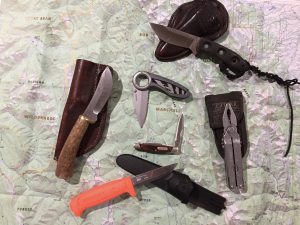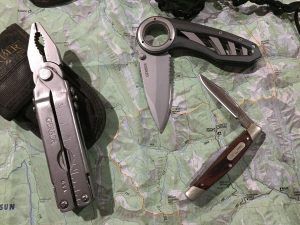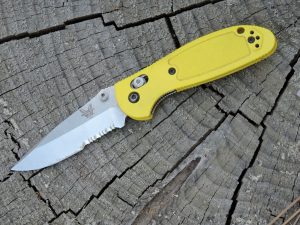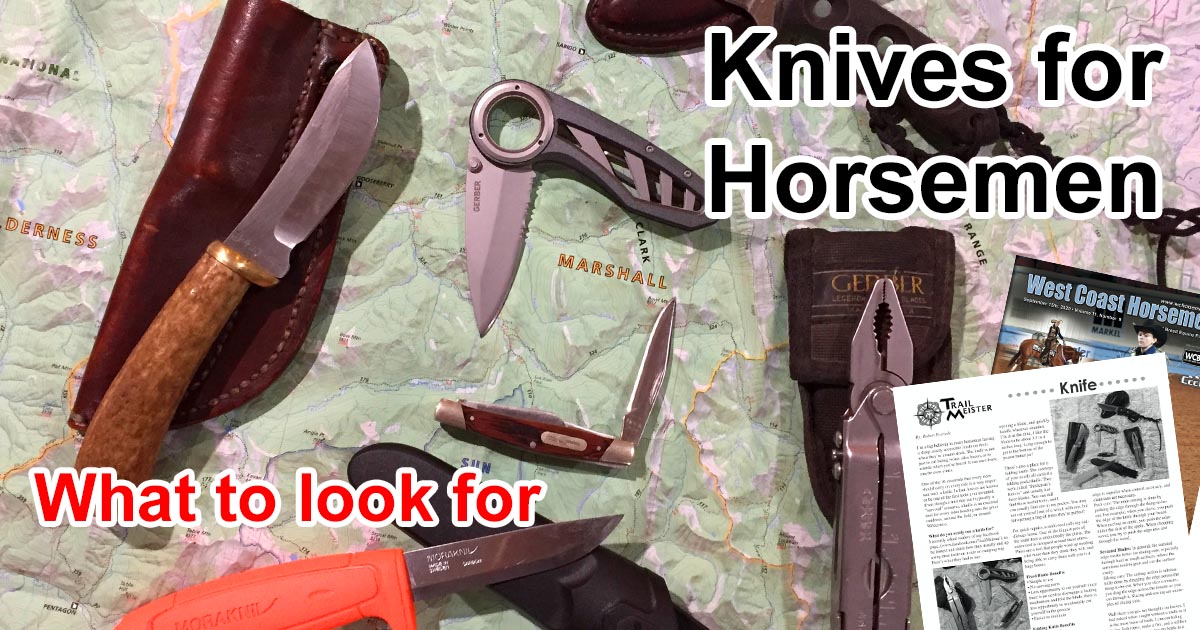Knives for Horsemen
As published in West Coast Horsemen Magazine – Sept 2020 edition
I’m a big believer in every horseman having a sharp, easily accessible, knife on them when they’re around stock. The knife is not just to cut baling twine, slice bacon, or to whittle when you’re bored. It can save lives; maybe yours.
 One of the 10 essentials that every rider should carry on every ride is a very important tool: a knife.
One of the 10 essentials that every rider should carry on every ride is a very important tool: a knife.
In fact knives are known to be one of the first tools ever invented. Even though a trail ride isn’t typically a “survival” scenario, a knife is an essential tool for every rider heading into the great outdoors; around the field or around a Wilderness.
What do you really use a knife for?
I recently asked readers of my facebook page (www.facebook.com/TrailMeister/) to be honest and share how they usually end up using their knife on a ride or camping trip. Here’s what they had to say:
Top 4 Uses for a Knife
- Opening packets (of food)
- Repairs
- Making a spark (with a fire steel)
- Cutting rope in case of a wreck
Other than the wreck these are pretty mundane uses. These are all normal reasons why we need a knife when we’re on the trail and they’re all valid.
But what type of knives for horsemen?
I prefer a fixed blade knife that I carry on my belt. In an emergency, I can pull it out, not worry about opening a blade, and quickly handle whatever situation I’m in at the time. I like the blade to be about 3.5 to 4 inches long. Long enough to get to the bottom of the peanut butter jar!
An inexpensive fixed blade knife is the Morakniv – https://amzn.to/3cFCSAz
There’s also a place for a folding knife. The cowboys of yore nearly all carried a folding pocketknife. They were called “Stockman’s Knives” and usually had three blades. You can still find these useful tools and I can usually find one in my pocket. You may not cut yourself out of a wreck with one, but for opening a bag of fritos they’re perfect!
One of my favorite pocket knifes is from Case – https://amzn.to/359O71T
 For quick repairs a multi-tool calls my saddlebags home. One of the biggest pros of the multi-tool is undoubtedly the pliers. The entire tool is designed around these pliers. Pliers are a tool that people wind up needing a lot more than they think they will, and being able to carry them with you is a huge bonus.
For quick repairs a multi-tool calls my saddlebags home. One of the biggest pros of the multi-tool is undoubtedly the pliers. The entire tool is designed around these pliers. Pliers are a tool that people wind up needing a lot more than they think they will, and being able to carry them with you is a huge bonus.
I’ve carried a Gerber Multitool for years – https://amzn.to/3eEAkEN
Fixed Blade Benefits
- Simple to use
- No moving parts
- Less opportunity to cut yourself (Since there is no need to disengage a locking mechanism and fold the blade, there is less opportunity to accidentally cut yourself in the process)
- Easier to maintain
Folding Knife Benefits
- No sheath required
- Stores more compactly
- Multi-use… If it’s a multi-tool, you’ll have additional gadgets beside the blade itself in one compact package
Serrated or not?
 Ropes today are often made of nylon or polypropylene, which can be hard to cut with an ordinary or plain blade. So, the serrated blade, or a partially serrated blade has become popular with many people.
Ropes today are often made of nylon or polypropylene, which can be hard to cut with an ordinary or plain blade. So, the serrated blade, or a partially serrated blade has become popular with many people.
Plain Blades: In general, a plain edge is best when doing push cuts. Also, the plain edge is superior when control, accuracy, and clean cuts are necessary.
The Benchmade has both plain and serrated edges for every job – https://amzn.to/3bJ43KA
Push cuts: The main cutting is done by pushing the edge through the thing-to-be-cut. For example, when you shave, you push the edge of the knife through your beard. When peeling an apple, you push the edge under the skin of the apple. When chopping wood, you try to push the edge into and through the wood.
Serrated Blades: In general, the serrated edge works better for slicing cuts, especially through hard or tough surfaces, where the serrations tend to grab and cut the surface easily.
Slicing cuts: The cutting action is substantially done by dragging the edge across the thing-to-be-cut. When you slice a tomato, you drag the edge across the tomato as you cut through it. Slicing and sawing are examples of slicing cuts.
Well there you go; my thoughts on knives for horsemen. I feel naked when caught without a knife as it is the most basic of tools. I can cut baling twine, lash ropes, make a fire and a million other uses. Heck, I even use my knife as a screwdriver at times. I urge you to find, and carry, a knife whenever you’re around horses and mules. You’ll wonder how you ever got around without one!
As always for more information on trail riding and camping with horses visit www.TrailMeister.com. It’s the largest guide to horse trails and camps in the world and is full of tips and tricks for trail riders.






